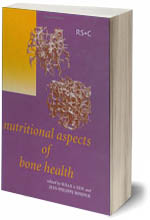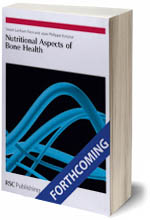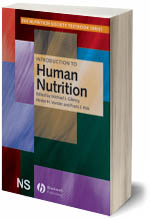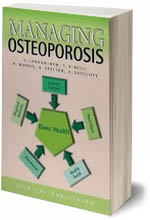Books on Bone Health
Nutritional Aspects of Bone Health
1st Edition
An in-depth review of the role of diet in the development and maintenance of bone health throughout the lifecycle, and prevention of osteoporosis in later life, this reference begins with an overview of what is meant by the terms bone health and osteoporosis. This includes key areas such as epidemiology, genetics and the impact of non-nutritional exogenous factors influencing the skeleton. The second section details the established nutritional factors affecting bone health, namely calcium and vitamin D. Section three focuses on the role of macronutrients and macrominerals in bone health, namely protein, phosphorus, sodium and potassium, including the criticality of acid-base homeostasis to skeletal integrity. Section four addresses the effects of microminerals, trace elements, vitamin K, vitamin A and isoflavones on bone.  Section five focuses attention on key issues connected with the influence of diet and anorexia and bulimia on bone health including nutrition and bone growth; nutrient-gene interactions; nutrient-drug interactions; and the final section discusses the effect of diet on reduction of fracture risk; the cost-effectiveness of nutritional supplements; and nutritional strategies for prevention and treatment of osteoporosis. The book is targeted at a number of key audiences. Whilst there is a focus on the academic research world and those principally involved in education, at both undergraduate and postgraduate levels, the book should also be of considerable interest to those participating in the treatment and prevention of osteoporosis, namely those working in the medical and health promotion fields. Furthermore, it should be of particular interest to the food industry as the popularity of foods designed to target specific health issues increases, and nutritional therapy has a critical role to play in this major public health problem.
Section five focuses attention on key issues connected with the influence of diet and anorexia and bulimia on bone health including nutrition and bone growth; nutrient-gene interactions; nutrient-drug interactions; and the final section discusses the effect of diet on reduction of fracture risk; the cost-effectiveness of nutritional supplements; and nutritional strategies for prevention and treatment of osteoporosis. The book is targeted at a number of key audiences. Whilst there is a focus on the academic research world and those principally involved in education, at both undergraduate and postgraduate levels, the book should also be of considerable interest to those participating in the treatment and prevention of osteoporosis, namely those working in the medical and health promotion fields. Furthermore, it should be of particular interest to the food industry as the popularity of foods designed to target specific health issues increases, and nutritional therapy has a critical role to play in this major public health problem.
Nutritional Aspects of Bone Health
2nd Edition
 Nutritional Aspects of Bone Health provides an in-depth review of the role of diet in the development and maintenance of bone health throughout the lifecycle, and prevention of osteoporosis in later life. The book is multi-authored by the worlds leading researchers in this area, who have come together to formulate the second edition following the sucess of the first ever textbook on nutritional aspects of bone health. This includes the current and cutting edge science underpinning the prevention of bone disease. The book is targeted at a number of key audiences. Whilst there is a focus on the academic research world and those principally involved in education, at both under graduate levels, the book will also be a considerable interest to those participating in the treatment and prevention of osteoporosis, namely those working in the medical and health promotion fi elds. Furthermore, this book will be of particular interest to the food industry as the popularity of foods designed to target specifi c health issues increases, and nutritional therapy has a critical role to play in this major public health problem. Examples of key areas to be covered: Calcium, vitamin D, vitamin K, protein, phosphorus Acid-base, potassium, magnesium, sodium Trace elements, vitamin A, folate and vitamin B complex, soy isofl avones Physical activity, gene:nutrient interactions, food groups, weight reduction, cost eff ectiveness of supplements.
Nutritional Aspects of Bone Health provides an in-depth review of the role of diet in the development and maintenance of bone health throughout the lifecycle, and prevention of osteoporosis in later life. The book is multi-authored by the worlds leading researchers in this area, who have come together to formulate the second edition following the sucess of the first ever textbook on nutritional aspects of bone health. This includes the current and cutting edge science underpinning the prevention of bone disease. The book is targeted at a number of key audiences. Whilst there is a focus on the academic research world and those principally involved in education, at both under graduate levels, the book will also be a considerable interest to those participating in the treatment and prevention of osteoporosis, namely those working in the medical and health promotion fi elds. Furthermore, this book will be of particular interest to the food industry as the popularity of foods designed to target specifi c health issues increases, and nutritional therapy has a critical role to play in this major public health problem. Examples of key areas to be covered: Calcium, vitamin D, vitamin K, protein, phosphorus Acid-base, potassium, magnesium, sodium Trace elements, vitamin A, folate and vitamin B complex, soy isofl avones Physical activity, gene:nutrient interactions, food groups, weight reduction, cost eff ectiveness of supplements.
Nutrition Society Textbook Series
2nd Edition
 The Nutrition Society Textbook series will provide students with the scientific basics in nutrition in the context of a systems and disease approach rather than on a nutrient by nutrient basis.
The Nutrition Society Textbook series will provide students with the scientific basics in nutrition in the context of a systems and disease approach rather than on a nutrient by nutrient basis.
In addition they will provide a means to enable teachers and students to explore the core principles of nutrition and to apply these throughout their training to foster critical thinking at all times.
Managing Osteoporosis
 This is the first in a series of practical books for clinicians setting out the options for effective management of chronic disease. There have been enormous advances in knowledge and understanding of the scientific and clinical aspects of osteoporosis over recent years. How do these advances translate into clinical practice, and in particular, how do we manage the continuing risk, or presence, of osteoporosis? Prevention and management involve maximising bone strength, optimizing diet, preventing falls, reducing the impact of falls and fractures, and understanding the potential psychological repercussions of the disease. This comprehensive review volume examines all these aspects, and provides clinicians with a thorough understanding of the factors which will enable them to formulate an appropriate strategy for treatment and long-term management for each individual patient.
This is the first in a series of practical books for clinicians setting out the options for effective management of chronic disease. There have been enormous advances in knowledge and understanding of the scientific and clinical aspects of osteoporosis over recent years. How do these advances translate into clinical practice, and in particular, how do we manage the continuing risk, or presence, of osteoporosis? Prevention and management involve maximising bone strength, optimizing diet, preventing falls, reducing the impact of falls and fractures, and understanding the potential psychological repercussions of the disease. This comprehensive review volume examines all these aspects, and provides clinicians with a thorough understanding of the factors which will enable them to formulate an appropriate strategy for treatment and long-term management for each individual patient.
